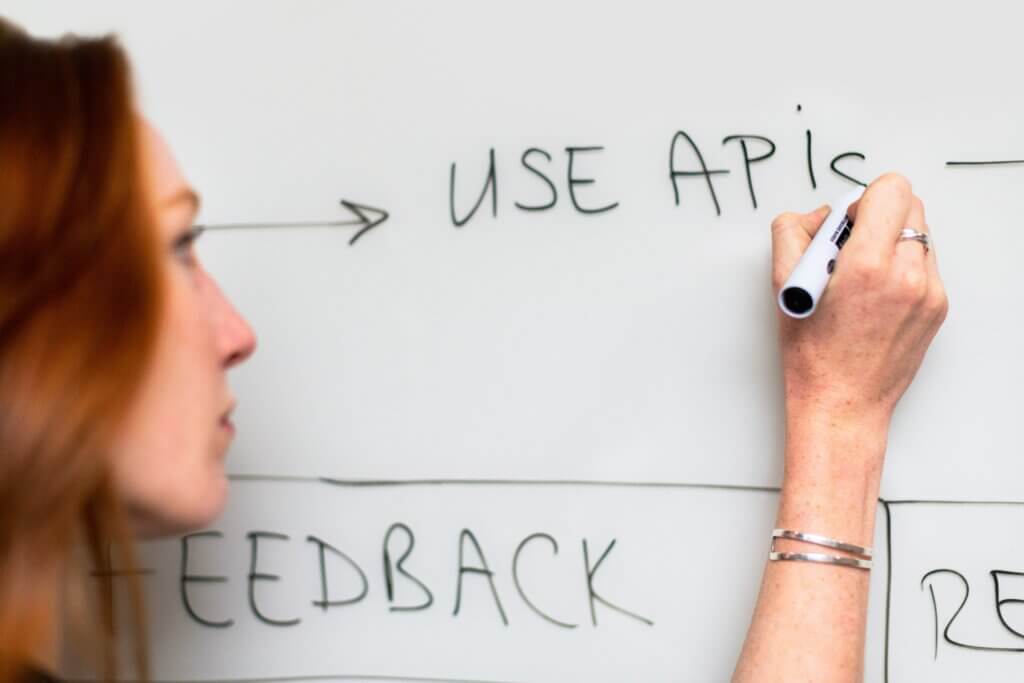After reading this article, you’ll:
- Grasp the fundamentals of third-party API integration in healthcare apps, including types of APIs, their protocols, and how they function in different healthcare contexts.
- Gain a balanced understanding of the pros and cons of using third-party APIs in healthcare applications, enabling informed decision-making for secure and compliant integrations.
- Acquire practical guidelines and best practices for successful API integration, from choosing scalable and trusted APIs to setting up backup API providers for uninterrupted service.

In today’s rapidly evolving healthcare landscape, the integration of APIs and third-party services is becoming increasingly vital. These integrations facilitate seamless data exchange, enhance functionalities, and provide opportunities for healthcare apps to be more versatile and user-friendly. This article outlines the best practices for integrating APIs and third-party services in healthcare apps, covering the types of APIs, selection criteria, pros and cons, and compliance with healthcare regulations. Whether you are a healthcare provider, a software developer, or a stakeholder looking to optimize healthcare operations, this guide offers key insights to make the most out of your API integrations.
Integrating APIs and third-party services with the help of a healthcare app development company is not just a technical exercise; it is a critical strategy for delivering high-quality, efficient, and secure healthcare services. By doing so, you can extend your app’s capabilities, ensuring a better user experience, greater operational efficiency, and compliance with various healthcare regulations.
What are APIs?
APIs, or Application Programming Interfaces, act as intermediaries that allow different software applications to communicate with each other. In the context of healthcare, APIs facilitate the exchange of information between various systems and applications—be it electronic health records (EHR), billing systems, or patient engagement platforms. By leveraging APIs, developers can quickly add functionalities like data storage, prescription fulfillment, and analytics to healthcare apps without having to build these components from scratch. Thus, APIs offer a streamlined approach to enhance both the service scope and the efficiency of healthcare applications.
Types of APIs
Understanding the different types of APIs is crucial when developing healthcare apps. The choice of API can have implications for functionality, scalability, and security. Here’s an overview of the common types of APIs you’ll encounter in the healthcare sector.
Public APIs
Public APIs are openly available for developers and other users with minimal restrictions. They are designed to be easily accessible and provide a piece of software that can be readily integrated into different projects. In healthcare, public APIs might offer functionalities like symptom checking or generic drug information. However, due to potential security risks and limited customization, public APIs are often not suitable for handling sensitive healthcare data.
Partner APIs
Partner APIs are designed for specific business use-cases and require special rights or licenses to access. They offer more robust security measures and are often tailored to specific healthcare needs, such as integrating electronic health records or insurance billing systems. These APIs usually have restricted access to pre-approved parties, ensuring a more controlled data exchange environment, which is essential in the healthcare industry.
Internal APIs
Also known as “private APIs,” these are developed for internal use within an organization. Internal APIs can be extremely useful for healthcare providers who use multiple software systems that need to communicate with one another. For example, a hospital might use an internal API to connect its patient records system with its billing software. Since these APIs are not exposed to external users, they offer the highest level of security but lack the broad-scale efficiencies gained from public or partner APIs.
Composite APIs
 Composite APIs allow developers to access multiple endpoints in one call, effectively combining different data and service APIs. These can be used to create more complex functionalities like simultaneously updating patient records, billing for services, and notifying healthcare providers of changes. In a healthcare setting, composite APIs can optimize workflows and improve operational efficiency by executing multiple tasks with a single API request.
Composite APIs allow developers to access multiple endpoints in one call, effectively combining different data and service APIs. These can be used to create more complex functionalities like simultaneously updating patient records, billing for services, and notifying healthcare providers of changes. In a healthcare setting, composite APIs can optimize workflows and improve operational efficiency by executing multiple tasks with a single API request.
Choosing the right type of API depends on multiple factors such as the required functionality, the level of security needed, and how widely the API will be used. Understanding these types is the first step toward effective integration.
How do APIs work: protocols and architectures
APIs operate on specific protocols and architectures that dictate how data is exchanged between systems. Understanding these technical foundations is essential for selecting the most appropriate API for your healthcare app’s unique needs. Below, we explore some of the most commonly used protocols and architectures, namely REST, SOAP, and RPC.
REST (Representational State Transfer)
REST is one of the most popular API architectures due to its simplicity and scalability. In a RESTful API, each URL represents an object, and HTTP methods (GET, POST, PUT, DELETE) define actions on those objects. REST APIs are stateless, meaning each request from the client contains all the information needed to process it. RESTful APIs are often preferred in healthcare for their ease of integration, modularity, and wide community support. They are commonly used for web services like patient portals and health information exchanges.
SOAP (Simple Object Access Protocol)
SOAP is another widely used protocol, especially in enterprise settings that require robust security and ACID-compliant transactions. Unlike REST, SOAP operates through XML-based messaging and involves more rigid standards and operations. SOAP APIs are well-suited for complex operations, such as those requiring high levels of security and transactions that involve multiple steps. In healthcare, SOAP is often used for exchanging information in a secure and standardized manner across different healthcare systems.
RPC (Remote Procedural Call)
 RPC is one of the older protocols for APIs and is based on the concept of executing a program or procedure on another system across the network. Unlike REST, which is resource-centric, RPC is action-oriented, focusing on what actions to take. RPC APIs can use multiple data formats, including XML and JSON. However, they are less common in modern healthcare apps due to their rigidity and the prevalence of REST and SOAP, which offer greater flexibility and standardization.
RPC is one of the older protocols for APIs and is based on the concept of executing a program or procedure on another system across the network. Unlike REST, which is resource-centric, RPC is action-oriented, focusing on what actions to take. RPC APIs can use multiple data formats, including XML and JSON. However, they are less common in modern healthcare apps due to their rigidity and the prevalence of REST and SOAP, which offer greater flexibility and standardization.
Choosing the right protocol and architecture for your API depends on various factors like security requirements, the complexity of tasks, and integration needs. Understanding the capabilities and limitations of each will help you make a more informed decision.
How to Choose the Right API Protocol for Your Third-Party Integration
Choosing the right API protocol is a pivotal decision when integrating third-party services into your healthcare application. Your choice will impact not only the functionalities you can offer but also the app’s performance, security, and compliance with healthcare regulations. Here are some key considerations to guide your decision-making process:
- Functionality Needs: Evaluate what you need the API to accomplish. REST is often more suitable for web services and applications that require CRUD (Create, Read, Update, Delete) operations. SOAP is more apt for complex transactions that involve multiple steps, like certain billing operations in healthcare. RPC may be beneficial for action-specific tasks, though it’s less commonly used nowadays.
- Security Requirements: Security is of paramount importance in healthcare. If you require stringent security measures, SOAP’s built-in security features via WS-Security may be advantageous. REST can also be secured but would usually require additional layers of security protocols.
- Interoperability: Consider how well the API needs to play with other systems. SOAP has been around for a longer time and is often used in legacy systems, which may make it a better fit for integrating with older healthcare systems. REST is generally easier to work with and has become the standard for most new web services.
- Scalability: If your app will require scaling, RESTful APIs are generally more flexible and easier to scale. Their stateless nature and modular architecture allow for better load balancing and simpler caching mechanisms.
- Ease of Use: If speed and ease of development are critical, REST is usually simpler to implement, requiring less rigid contracts and formalities than SOAP.
- Compliance: Last but not least, make sure the API you choose is compliant with healthcare standards and regulations like HIPAA in the U.S. or GDPR in Europe. Both SOAP and REST can be compliant but check if the third-party service has necessary certifications.
- Community and Support: Finally, consider the ecosystem around the API. A larger community often means more extensive documentation and a greater pool of experienced developers.
By carefully weighing these factors based on your specific needs, you can choose the API protocol that best suits your healthcare app’s third-party integration requirements.
Pros and Cons of Third-Party APIs for Healthcare Apps
Third-party APIs can be a game-changer in healthcare apps, enabling rapid development, extended functionalities, and enhanced user experiences. However, while they come with several advantages, there are also downsides to be aware of, especially in a sensitive field like healthcare.
Pros of Third-Party APIs for Healthcare Apps
- Rapid Development: Leveraging third-party APIs allows developers to implement complex functionalities without having to build them from scratch, thus speeding up the development process.
- Cost-Efficiency: Developing custom functionalities can be expensive and time-consuming. Third-party APIs often provide a more cost-effective way to add specialized services to healthcare apps.
- Scalability: Many third-party APIs are designed to handle a broad range of scales, making it easier for your app to grow and adapt to increased user demand without requiring substantial changes to the underlying architecture.
- Feature-Rich: APIs can bring a plethora of features that may otherwise be too resource-intensive to develop, such as advanced analytics, telemedicine capabilities, and real-time data synchronization.
- Compliance and Security: Reputable third-party APIs in the healthcare sector often come with built-in compliance for regulations like HIPAA, making it easier to maintain high levels of data security and patient privacy.
- Interoperability: With APIs designed to interface smoothly with existing healthcare systems like Electronic Health Records (EHR) and Pharmacy Benefit Managers (PBM), integration challenges can be significantly reduced.
Cons of Third-Party APIs for Healthcare Apps
- Security Risks: While many third-party APIs offer robust security, introducing external services can create vulnerabilities, especially if the API provider does not meet healthcare compliance standards.
- Limited Control: When you use a third-party API, you’re dependent on another entity for that segment of your service. If they experience downtime, make unfavorable updates, or discontinue their service, it directly affects your app.
- Cost Over Time: While third-party APIs may reduce upfront development costs, their subscription or usage fees can add up over time, making them potentially more expensive in the long run.
- Data Privacy: Utilizing external services often means that you’re entrusting sensitive patient data to a third party, which could raise concerns about data ownership and privacy.
- Complexity and Learning Curve: Each API comes with its own set of rules, documentation, and intricacies that your development team needs to learn, which could slow down the development process initially.
- Vendor Lock-in: Some APIs may use proprietary data formats or protocols that make it difficult to switch providers later on, thereby limiting your flexibility.
Understanding these pros and cons will enable you to make a more informed decision when integrating third-party APIs into your healthcare app. It’s critical to assess each API’s capabilities and limitations in the context of your specific requirements and constraints.
Best Practices for Third-Party API Integrations
Successfully integrating third-party APIs into your healthcare app requires more than just selecting the right API. Following best practices can help you get the most out of these integrations while mitigating potential risks.
Look Through The API Documentation
Before integrating an API, it’s crucial to thoroughly read and understand its documentation. Good documentation should provide clear information on how to set up the API, its functionalities, required parameters, and security features. This will give you a solid foundation for successful integration and help you identify any limitations or special requirements upfront.
Only Work With Trusted and Well-Tested APIs
Given the sensitive nature of healthcare data, it’s essential to only work with reputable API providers. Look for APIs that have a proven track record in the healthcare sector and are compliant with regulations like HIPAA. Checking reviews, case studies, and asking for recommendations can help you find trusted providers.
Select Scalable APIs
Your healthcare app will likely grow over time, so choosing an API that can scale to meet your future needs is vital. Scalable APIs should offer robust performance and quick response times, even as request volumes increase. They should also allow for easy addition of new features without requiring a complete overhaul of your existing system.
Test The API Yourself
Never assume an API will work perfectly with your healthcare app without testing it first. Run the API in a controlled environment to evaluate its performance, reliability, and security. This not only helps you identify potential issues before they become major problems but also allows you to better understand how the API will interact with your existing infrastructure.
Have a Backup API Provider
Even the most reliable APIs can experience downtime or other issues. Having a backup API provider can help you maintain service continuity in such scenarios. It’s good practice to have contingency plans and failover mechanisms in place, so you can switch to an alternate provider with minimal disruption.
By adhering to these best practices, you can greatly increase the likelihood of successful API integration, ensuring that your healthcare app remains reliable, secure, and capable of delivering high-quality service to its users.
Top 3 Use Cases For Third-Party APIs in Healthcare Apps
The use of third-party APIs can significantly extend the capabilities of healthcare apps, making them more robust, feature-rich, and user-friendly. Here are three compelling use cases where APIs can make a significant difference.
Healthcare Data Storage API
Storing healthcare data securely and efficiently is crucial. Third-party APIs specializing in healthcare data storage often come with built-in security features and are HIPAA-compliant, reducing the burden on developers to build these features from scratch. Such APIs offer scalable solutions to store patient records, test results, and other sensitive information securely in the cloud, thereby enabling seamless access for authorized personnel and enhancing patient care.
Prescription Fulfillment API
Prescription fulfillment APIs enable healthcare apps to integrate directly with pharmacies and medication distribution networks. These APIs facilitate electronic prescription services, allowing doctors to send prescriptions directly to pharmacies, which can then notify patients when their medication is ready for pickup or delivery. This adds a layer of convenience and efficiency, making medication management easier for both healthcare providers and patients.
Analytics API
Analytics play a crucial role in healthcare for tracking patient outcomes, resource allocation, and treatment effectiveness. Third-party analytics APIs can be integrated into healthcare apps to provide advanced data analysis and visualization capabilities. These APIs can help generate real-time reports, dashboards, and alerts, enabling healthcare providers to make more informed decisions based on comprehensive data insights.
By leveraging these types of third-party APIs, healthcare apps can offer more comprehensive services, from secure data storage to efficient prescription fulfillment and advanced analytics, thus providing immense value to both healthcare providers and patients.
Integrating third-party APIs into healthcare apps can offer numerous benefits, such as rapid development, enhanced features, and cost-efficiency. However, it’s crucial to approach this integration with due diligence, given the sensitive nature of healthcare data and the regulatory landscape. By understanding the types of APIs available, choosing the appropriate protocol, weighing the pros and cons, and adhering to best practices, healthcare apps can successfully leverage third-party APIs to deliver robust, secure, and highly functional services. With the right approach, these APIs can significantly elevate the quality of care and patient experience.





